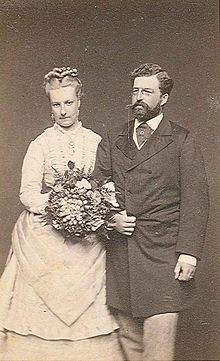Prince Philipp of Saxe-Coburg and Gotha
You can help expand this article with text translated from the corresponding article in French. (October 2012) Click [show] for important translation instructions.
|
| Prince Philipp | |||||
|---|---|---|---|---|---|
| Prince of Saxe-Coburg and Gotha Duke of Saxony | |||||
 Philipp and Louise | |||||
| 3rd Head of the House of Saxe-Coburg and Gotha-Koháry | |||||
| Tenure | 26 July 1881 – 3 July 1921 | ||||
| Predecessor | Prince August | ||||
| Successor | Prince Pedro Augusto | ||||
| Born | 28 March 1844 Paris | ||||
| Died | 3 July 1921 (aged 77) Coburg | ||||
| Burial | |||||
| Spouse | Princess Louise of Belgium | ||||
| Issue | Prince Leopold Clement Dorothea, Duchess of Schleswig-Holstein | ||||
| |||||
| House | Saxe-Coburg and Gotha-Koháry | ||||
| Father | Prince August of Saxe-Coburg and Gotha | ||||
| Mother | Princess Clémentine of Orléans | ||||
| Religion | Roman Catholic | ||||
Ferdinand Philipp Maria August Raphael of Saxe-Coburg and Gotha (28 March 1844, Paris – 3 July 1921, Coburg) was the second prince of Saxe-Coburg and Gotha and lord of Csábrág and Szitnya, both in modern-day Slovakia.
Life
Born in the Tuileries Palace in Paris as Ferdinand Philipp Maria August Raphael of Saxe-Coburg and Gotha, he was the eldest son of August, prince of Saxe-Coburg and Gotha, and Clémentine of Orléans. His mother was a daughter of King Louis Philippe I of France. He was a member of the Catholic Koháry line of the House of Wettin and an elder brother of Ferdinand, tsar of Bulgaria.
In 1870, he became a Major in the Hungarian army. He was a close confidant to his brother-in-law, Crown Prince Rudolf.[1] On the morning of 30 January 1889, he and Count Josef Hoyos-Sprinzenstein and valet Johann Loschek discovered the bodies of Rudolf and his teenage mistress Baroness Mary Vetsera, who had also been shot dead.[2]
Philipp spent his last years at Bürglaß castle in Coburg. He died in 1921, aged 77. He was buried in the Koháry crypt in the St. Augustin church in Coburg. He was a knight in the Order of the Golden Fleece and a recipient of the Portuguese Order of the Tower and Sword.
Marriage and issue
In Brussels on 4 February/4 May 1875, Philipp married Louise, princess of Belgium, his second cousin, daughter of Leopold II, king of the Belgians and granddaughter of Leopold I, king of the Belgians, brother of Philipp's grandfather Ferdinand.
The marriage of Philip and Louise proved disastrous and she left her husband in 1896. In 1898, she lost parental power over her children and on 15 January 1906, the divorce was pronounced in Gotha.[3] The reason for the separation was her long-standing relationship with Count Géza of Mattachich-Keglevich (1867-1923), with whom Philipp had dueled on the orders of Emperor Franz Josef I.[4][5] Louise had had other affairs before she met Géza, among others with Philipp's adjutant.
They had two children:
- Leopold Clement Philipp August Maria (19 July 1878, Szent-Antal, Hungary - 27 April 1916, Vienna); he died when a former lover flung acid in his face.
- Dorothea Maria Henriette Auguste Louise (30 April 1881, Vienna - 21 January 1967, Taxis, Württemberg), married on 2 August 1898 to Ernst Günther, duke of Schleswig-Holstein-Sonderburg-Augustenburg.
Numismatics
Prince Philip had an important collection of coins from Saxony, the East and overseas. He published about Oriental numismatics. His coin collection was auctioned in 1928 by the auction house Leo Hamburger in Frankfurt. Several commemorative medals were issued during his lifetime, for example in 1875 on the occasion of his marriage to Louise and in the same year for his honorary membership of the Belgian Numismatic Society.
Ancestry
Footnotes
- ^ "Mayerling: Die Personen".
- ^ Margot Judtmann: Mayerling ohne Mythos: ein Tatsachenbericht, Kremayr & Scheriau, 1982, S. 35
- ^ Karl Kraus, Frank Wedekind: Briefwechsel 1903 bis 1917, Königshausen & Neumann, 2008, p. 390
- ^ http://www.belgieninfo.net/artikel/view/datum/2009/03/21/belgiens-unglueckliche-braeute-teil-3.html
- ^ Christoph Ohlig: Wasserhistorische Forschungen: Schwerpunkt Montanbereich, Books on Demand, 2003, p. 142
